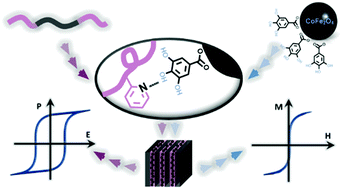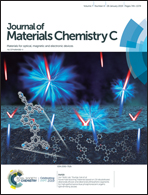Polymer-based multiferroic nanocomposites via directed block copolymer self-assembly†
Abstract
The existence of ferroelectricity and ferromagnetism in multiferroic materials and their coupling enables the manipulation of the electric polarization with applied magnetic field and vice versa, opening many doors for the practical applications. However, the preparation of polymeric multiferroic nanocomposites is often accompanied with aggregation of magnetic particles inside the ferroelectric polymeric matrix. To overcome this issue, we developed a simple and straightforward method to obtain multiferroic nanocomposites with an exceptional and selective dispersion of magnetic nanoparticles, using self-assembly of poly(vinylidene fluoride) (PVDF)-based block copolymers. Magnetic cobalt ferrite nanoparticles modified with gallic acid are selectively incorporated within poly(2-vinylpyridine) (P2VP) domains of the lamellar block copolymer due to strong hydrogen bond formation between the ligand and the P2VP block. Using this approach, phase separation between the blocks is improved, which leads to an increase in the degree of crystallinity, whereas the selective dispersion of nanoparticles inside amorphous domains prevents changes in the crystalline phase of the ferroelectric block. The obtained nanocomposites demonstrate both ferroelectric and magnetic properties without large conductive losses at high electric field, making them good candidates for improved multiferroic devices.



 Please wait while we load your content...
Please wait while we load your content...